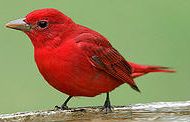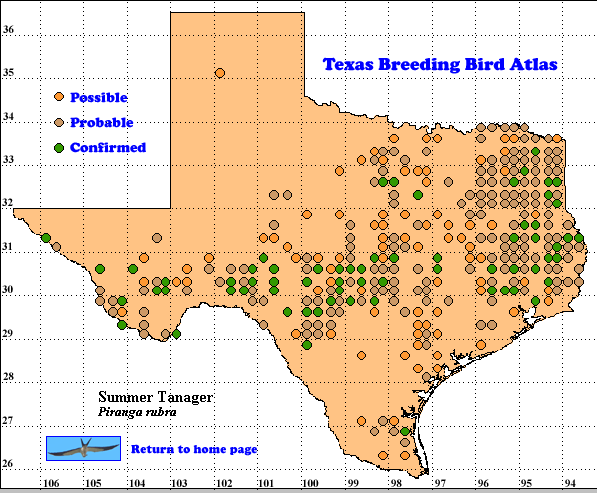Summer Tanager is another North American breeding species with eastern and western populations, often separated by the Great Plains. Because of its location and size, Texas often has breeding populations of both groups or subspecies. Oberholser (1974) indicates the Pecos River as the approximate dividing line between the eastern subspecies (P. r. rubra) and (P. r. cooperi) the western subspecies. Although there is a slight difference in plumage color, the appearance of the nest may provide the most reliable clue (Robinson 1996, Pyle 1997).
During their breeding season in North America, Summer Tanagers feed primarily on adult bees and wasps which they capture in mid-air and beat senseless against a perch before consuming or feeding to their young. These tanagers also consume other insects and add fruits to their diet in migration and winter (Robinson 1996).
DISTRIBUTION. During the 1987-1992 field work seasons of the TBBA project, researchers found breeding evidence for Summer Tanagers most commonly in the Pineywoods, Post Oak Savannah and Blackland Prairies regions in east Texas, followed by the Edwards Plateau, Trans-Pecos and Coastal Prairies regions. Only a single probable record was found in the Panhandle with a few records in the Rolling Plains and South Texas Brush Country (see the region map in Lockwood and Freeman [2004]). Atlasers found 76 confirmed, 355 probable and 191 possible breeding sites. In Oklahoma atlasers found almost all of the 193 breeding records east of the 98th meridian (Bay 2004).
The breeding range of Summer Tanager extends east from Texas and Oklahoma to the Atlantic Coast and north to southern Missouri, the Ohio River valley and southern New Jersey, excluding south Florida and the Appalachian Mountains. The highest relative abundances (averaging 10-30 tanagers per North American Breeding Bird Survey [BBS] route) were found in the Pineywoods and in east Oklahoma (Sauer et al. 2005).
From Texas the breeding range extends west to California and south into northern Mexico. In winter Summer Tanagers are found from central Mexico through Middle America to Ecuador and Brazil (Howell and Webb 1995, Sauer et al. 2005).
SEASONAL OCCURRENCE. Most Summer Tanagers arrive in Texas from late March to mid-May as uncommon to common migrants. Some remain to breed from late March to mid-July, based on egg dates from April 30 to June 17 and TBBA observations from March 27 to June 13. Southbound migration occurs between mid-August and late October (Oberholser 1974, Lockwood and Freeman 2004).
BREEDING HABITAT. In Texas Summer Tanagers breed from near sea level to 1500 or possibly 2000 m (5000-6500 ft) in oak, hickory, pecan or pine woodlands in east and central parts of the state and in riparian habitats in the Trans-Pecos region.as well as other areas of Texas (Oberholser 1974, Skoruppa and Blacklock 2007). In eastern Oklahoma this species prefers open, upland deciduous mixed woodlands (Bay 2004), while in Arizona atlasers found 91% of breeding sites for Summer Tanagers in riparian areas (Corman 2005).
Eastern nests are usually built in a clump of leaves or in a fork of a horizontal branch, well out from the trunk and often overhanging an open area. The height above the ground varies widely from 1.3 to >22 m (4-73 ft).. The nest of eastern birds is unkempt, sometimes with materials hanging as much as >0.2 m (8 in) below the nest. It is often a flimsy structure, built by the female of dried herbaceous vegetation, sometimes thin enough that the eggs can be seen from below. These nests and eggs are often indistinguishable from those of Scarlet Tanagers (Piranga olivacea). In contrast, nests of western populations are well-constructed and sturdy with solid bottoms (Harrison 1979, Robinson 1996)..
The usual clutch is about 3 or 4 (range 2-5) smooth, pale blue to green eggs, variably marked with brown spots, speckles or blotches (see Harrison [1979] for a photo of markings). The female incubates the eggs for 11-12 days and the nestlings leave the nest on days 9-10 (range 8-12) after hatching and are fed by their parents for at least 3 more weeks. Rates of parasitism by Frown-headed Cowbird )Molothrus ater) may be very high, but reduction in young tanagers fledged is only about 20%. (Robinson 1996).
STATUS. The map in Oberholser (1974) is generally similar to the TBBA nap. Lockwood and Freeman (2004) describe Summer Tanager as a rare to locally common summer resident in most of the state. BBS data show relative abundances varying from 1-3 tanagers near the Rio Grande River in the Trans-Pecos and along the coast in the Coastal Sand Plain to 3-10 on the Edwards Plateau and as high as 10-30 in the Pineywoods. Data from 81 BBS routes in Texas produce a statistically significant +0.4% annual population change for the period 1980-2005 (Sauer et al. 2005). These results are encouraging for the future of Summer Tanagers as Texas breeding birds. Text by Robert C. Tweit (2007)
Corman, T. E. 2005. Summer Tanager (Piranga rubra). In Arizona breeding bird atlas. pp. 488-489 (T. E. Corman and C. Wise-Gervais, eds.). University of New Mexico Press, Albuquerque.
Robinson, W. D. 1996. Summer Tanager (Piranga rubra). In The birds of North America, No. 248 (A. Poole and F. Gill, eds.). The Birds of North America, Inc., Philadelphia, PA.
Sauer, J. R., J. E. Hines, and J. Fallon. 2005. The North American Breeding Bird Survey, results and analysis 1966-2005. Version 6.2 2006. USGS Patuxent Wildlife Research Center, Laurel MD < http://www.mbr-pwrc.usgs.gov/bbs>
Skoruppa, M. K. and G. W. Blacklock. 2007. Three noteworthy species of woodland birds in a riparian forest of the lower Nueces River, San Patricio County, Texas. Bull. Texas Ornithol. Soc. 40: 14-15.

